British Rail Class 37
| English Electric Type 3 British Rail Class 37 | |||||||||||||||||||||||||||||||||||||||||
|---|---|---|---|---|---|---|---|---|---|---|---|---|---|---|---|---|---|---|---|---|---|---|---|---|---|---|---|---|---|---|---|---|---|---|---|---|---|---|---|---|---|
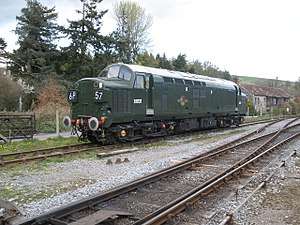 British Railways Class 37 | |||||||||||||||||||||||||||||||||||||||||
| |||||||||||||||||||||||||||||||||||||||||
| |||||||||||||||||||||||||||||||||||||||||
| |||||||||||||||||||||||||||||||||||||||||
| |||||||||||||||||||||||||||||||||||||||||
The British Rail Class 37 is a diesel-electric locomotive. Also known as the English Electric Type 3, the Class was ordered as part of the British Rail modernisation plan. They were numbered in two series, D6600-D6608 and D6700-D6999.[4]
The Class 37 became a familiar sight on many parts of the British Rail network, in particular forming the main motive power for Inter-City services in East Anglia and within Scotland. They also performed well on secondary and inter-regional services for many years. The Class 37s are known to some railway enthusiasts as "Tractors",[3] a nickname due to the agricultural sound of the diesel engine of the locomotive.
Despite all members of the build now being over 50 years old, over 60 locomotives are still mainline registered and remain active undertaking a variety of passenger, freight and departmental duties on the national rail network in 2018. Approximately 30 locomotives have been preserved.
Description
Background
As part of the large scale dieselisation brought about by the British Rail modernisation plan a need was identified for a number of type 3 locomotives of power output 1,500 hp (1,100 kW) to 1,999 hp (1,491 kW). English Electric had already been successful with orders for type 1 and type 4 diesels, and had produced locomotives of similar power to that which was required for railways in East Africa. A design based on the exported locomotives was put forward and accepted.[5] The design was for a general purpose locomotive and initially found service in British Rail's Eastern Region.[6]
Building
There was no prototype. British Rail first placed an order for 42 Class 37 locomotives in January 1959.[7] The first of these was delivered in November 1960, entering service on 2 December,[8] with the last of this original batch complete by mid-1962, by which time subsequent orders had been placed. The last of the 309 built was delivered to the Western Region on 9 November 1965.[9] English Electric split the construction between their Vulcan Foundry at Newton-le-Willows, and Robert Stephenson and Hawthorns of Darlington.[1] The 309 locomotives produced in total were originally numbered in the range D6700-D6999 and D6600-D6608. The bodywork bears a strong family resemblance to other English Electric designs such as the Class 40 and Class 23 'Baby Deltic'.
Seven orders were placed with English Electric, as follows:[10]
| EE order no. | Date | Total | Numbers | Works |
|---|---|---|---|---|
| CCL 1031 | 27 January 1959 | 42 | D6700–41 | Vulcan Foundry |
| CCM 1114 | 5 February 1960 | 37 | D6742–68 | Vulcan Foundry |
| D6769–78 | Robert Stephenson and Hawthorns | |||
| CCN 1239 | 27 April 1961 | 17 | D6779–95 | Robert Stephenson and Hawthorns |
| CCP 1267 | 13 December 1961 | 23 | D6796–6818 | Vulcan Foundry |
| CCP 1304 | July 1962 | 100 | D6819–28, D6859-68, D6879-98 | Robert Stephenson and Hawthorns |
| D6829–58, D6869-78, D6899-6918 | Vulcan Foundry | |||
| CCR 1320 | January 1964 | 20 | D6919–38 | Vulcan Foundry |
| CCS 1362 | February 1964 | 70 | D6939–99, D6600–8 | Vulcan Foundry |
Duties
The class was designed for both passenger and freight work and was as much at home hauling heavy goods trains as it was on passenger services. Many of the original locomotives were fitted with boilers for steam heating. D6700-6754 were fitted with boilers from new, along with D6758, D6775, D6781-D6818, D6875-D6892. D6960-6968 received boilers from D6701-6709 during 1967/68. 37247 was fitted with a boiler in 1977. With the withdrawal of many Type 2 and Type 3 locomotives in the 1980s the 37s were selected as the standard Type 3 and many of the fleet were given a heavy overhaul to prolong their life into the 1990s and beyond. Some were fitted with electrical train heating (ETH) equipment in the 1980s to become the 37/4 sub-class, initially for use on the West Highland Line, the Marches line and South Wales - Bristol area services and Far North lines but later seeing use in north/mid Wales and occasionally the West Country. They have more recently been used on the Cumbrian Coast line and on vice dmu turns around Norwich.
Rebuilding
A number of locomotives were rebuilt as Class 37/9s in the late 1980s to evaluate Mirrlees and Ruston engines for possible use on a new Class 38 freight locomotive. These 'Slugs' were heavily ballasted to improve traction and had excellent load-hauling capabilities, but the Class 38 (understood to be a 'modular' locomotive based on the approach that gave rise to the Class 58 and the unbuilt Class 88 electric loco) was never built.
Axle load
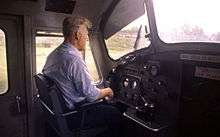
The Class 37 has a relatively low axle loading for its size and power. With the withdrawal of most of the smaller types of diesel locomotive, this left it as the only mainline type available in significant numbers for lines with weight restrictions, and for a number of years 37s handled almost all locomotive-hauled services on the West Highland Line, the lines north of Inverness (Far North Line) and in parts of Wales. The Class 37 has Route Availability 5 and this is one of the main reasons it is still in use on the network. Note class 37/7 and 37/9 have an RA of 7 due to their extra ballast weights.
Regional variations
There are several differences between particular locomotives, some of them easily seen. Western Region Class 37s can be identified by 'cow horns' around halfway up on the outer edge of each end of the lamp brackets. When British Railways took over from the Great Western Railway the use of Great Western lamps continued. Their brackets used an L-shaped upright that was parallel to the direction of travel, unlike the other regions which used transverse brackets. Another difference between the regions is by the nose end headcodes. Lower-numbered, split-box Class 37s were allocated to northern England and east Anglia; centre-box locomotives were almost all allocated to Wales and the south west. After locomotives were transferred between pools in the 1980s they tended to stray from their original depots. Regional decorations included the Highland (Inverness) Stag, the Cockney Sparrow (Stratford) the Cornish lizard (St Blazey) and Eastfield Highland Terrier. All the Cardiff Canton Class 37/4s received Celtic Dragons below the driver's window whilst in large logo blue. Some Scottish locomotives were later fitted with small Saltire flags by their TOPS data panels or on their noses in a similar fashion to the HAA hoppers allocated to Scottish power stations.
British Rail liveries
On delivery, the Class 37s were painted in plain green with a grey roof, the 'late' (post-1956) British Railways crest and a D prefix to their running number. Some locomotives were delivered as the small yellow warning panel was introduced, earlier locomotives being given these panels during works visits. Towards the late 1960s, the yellow was extended to the full height of the nose.
By the 1970s, all locomotives had received all over British Rail blue with a full yellow nose; by 1975 most locomotives had also received their TOPS numbers. Their livery remained the same until the early 1980s when 'Large Logo blue' was introduced. This entailed the yellow nose continuing round to behind the driver's door and up to the top of the windscreen and a full height 'double arrow' logo. These locomotives had the top of the nose painted black to lower the risk of the driver being dazzled by the sun. Freight-allocated examples received a similar livery - the only difference being the blue was replaced by freight grey. In 1987, the Sectors were launched, incorporating a new livery of 'three tone grey'; a light grey lower bodyside, medium grey cantrail and a dark grey roof, along with a bright Sector logo (Coal, Metals, Petroleum, Distribution, General and Construction). In addition a metal double arrow logo was fitted. This livery co-existed with plain blue, large logo blue/grey and the new Intercity and Regional Railways liveries right up to the end of British Rail in 1996.
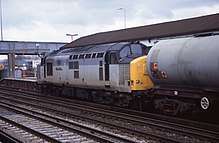
Some locomotives in the 'sectorised company' pools received Transrail logos or Mainline 'Rolling Balls' over their 3TG (three tone grey) colours, while Loadhaul locomotives were painted orange & black and Mainline locomotives received 'aircraft' blue with silver stripes. Departmental locomotives were initially painted in a plain grey livery, but this didn't find favour and was modified into 'Dutch' grey and yellow livery, similar to that of Nederlandse Spoorwegen. 37 093 was mocked up as a "police" locomotive which pulled over a Class 43 HST power car for speeding in an "InterCity 125" advert broadcast in the 1980s.
TOPS renumbering
As with many diesel classes, the TOPS renumbering was implemented in a straightforward manner, with the locomotive numbers remaining in sequence. Thus 6701 became 37001 and D6999 became 37299; while D6600 - D6608 became 37300 - 37308. The remaining locomotive, D6700 became 37119 instead of D6819 which became 37283 (redundant number as D6983 was destroyed in an accident in 1965).[11] As members of the class were altered later in their careers, they were renumbered, some more than once.
D6983 was withdrawn in December 1965 following a fatal collision with a derailed Class 47, number D1671, in South Wales, near Bridgend as the result of a landslip. D6983 was the first EE Type 3 to be withdrawn and as a result, the only locomotive in the entire class not to receive a TOPS number. The remains of both locomotives were sold to local scrap merchants, R.S. Hayes, and cut up the following year.[12]
Sub-classes
In the 1980s the Class 37 locomotives were extensively refurbished - from that point 37/0 refers to the original version. The work took place at BREL in Crewe except for the 37/3 subclass whose bogies were replaced at various depots.[1]
| Sub-class | Description |
|---|---|
| 37/0 | Locomotives which remained unmodified after other sub-classes were created |
| 37/3 | Locomotives which were rebogied but not refurbished |
| 37/4 | Refurbished, rewired, English Electric generator replaced with Brush alternator, electric train supply (ETS) fitted |
| 37/5 | Refurbished, rewired, English Electric generator replaced with Brush alternator |
| 37/6 | Locomotives from Class 37/5 further modified with through ETS wiring and RCH jumper cables |
| 37/7 | Refurbished, rewired, English Electric generator replaced with GEC G564AZ or Brush alternator,[1] additional weight added |
| 37/9 | Refurbished, rewired, English Electric generator replaced with Brush alternator, new engines: Mirrlees MB275Tt or Ruston RK270Tt[1] |
Class 37/0
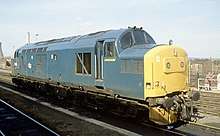
This designation covered all 309 locomotives as built, but with such a large number of locomotives and with two companies involved in the building, there were several differences within this sub-class alone. The most visible external difference was that the first 119 locos had a "split" headcode box; for these locos the four digit Train reporting number was shown in two square boxes containing two digits and separated by a pair of doors designed to allow the train crew to be exchanged while in motion. Later locomotives had a single centrally placed headcode box, and also had the horns mounted on the roof rather than built into the nose of the locomotive. This difference was the reason for the double change in numbers when implementing the TOPS scheme described earlier.
Class 37/3

There were two incarnations of a 37/3 subclass. The first was a group of 12 Motherwell allocated locos that were fitted with strengthened couplings and modified brake blocks for working the heavy trains to Ravenscraig. These were all renumbered back to their original numbers by the end of 1988.
The second set of locos were rebogied at various depots with the regeared Cast bogie frame type 'CP7 Bogie' (bogies from the English Electric Deltics, Class 50 and Class 37s are largely interchangeable with only modification to traction motor gearing to 80 miles per hour (130 km/h) and access step positions needing alteration between the classes), the fuel capacity was doubled (by using the redundant train heating boiler water tanks) but no other changes were made.[13]
Class 37/4

With ETH (Electric Train Heating) replacing 'steam heated' coaches, some of this class received ETH Supply when refurbished at Crewe Works during 1985 and 1986. During this refurbishment, the locomotives also received regeared CP7 bogies and the English electric generator was replaced with a Brush BA1005A alternator.[14] Extensive re-wiring, as well as a full repaint into BR Large Logo was undertaken. The modifications allowed the 're-built' locomotives to work passenger trains all year round, with the 31 strong fleet being split between Wales and Scotland, Scotland receiving the first 25 and Wales the next 6.
After the extensive refurbishment, the locomotives were allocated the 37/4 sub-class, following the trend of renumbering 'ETH' fitted locomotives xx/4s, (e.g. 47 4xx and 31 4xx).
The next chapter saw the entire sub-class pass to Trans-Rail, which was one of the three regional freight operating companies prior to the privatisation of the entire British Rail network.
Over the years, the locomotives have received a large number of liveries: BR Green, Regional Railways, Trainload Grey, EWS maroon, Trans-Rail, BR Large Logo and Mainline, to name a few.
The Cambrian Coast lines, the North Wales Coast Line, The Rhymney Valley Line, Fort William and Oban, South Wales Main Line, and the West Country all benefited from the use of 37/4s. They were operated by EWS and often found use on Railtours and aluminium traffic. EWS used to cycle 37/4s in and out of traffic on a regular basis, depending on demand. All have subsequently been sold to DRS by EWS's successor DB Schenker (see below).
Loco hauled operations have taken a big hit within the past couple of years, thanks to the widespread introduction of diesel multiple units, and the replacement of loco hauled trains by multiple units, although the sub-class did hold out on the Cardiff - Rhymney trains for Arriva Trains Wales latterly. 37411 and 37425 were painted especially to mark the end of loco hauled service on the line in April 2005, these repaints being funded by Arriva.
In late 2010, DB Schenker put all of its remaining 37/4s up for sale with many examples expected to be sold for scrap. DRS has since bought the remaining class 37/4s as of April 2011.[15] The DRS ones are currently (Summer 2017) used on Northern services on the Cumbrian Coast and on local Anglian services from Norwich.
Class 37/5
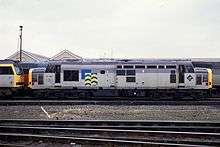
This class were updated in similar fashion to the 37/4 subclass, except that they did not receive Electric Train Heating and some were fitted with Sandite ports. Locomotives previously numbered between 37001 and 37119 (those which had split headcode boxes) were given new numbers from 37501 upwards; those previously numbered between 37120 and 37308 were renumbered from 37699 downwards (locomotives 37601-37612 were Class 37/6, not Class 37/5).
Class 37/6
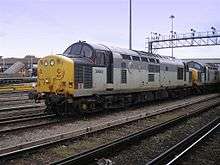
Eurostar (at the time European Passenger Services) had 12 locomotives modified (all ex-37/5) as Class 37/6, with the intention that they would haul overnight international trains ("Nightstar") over the non-electrified sections of their routes in Britain. However, these services were never introduced, and, in 1997, Eurostar sold six of its locomotives to DRS, with a further three sold in 2000. The remaining three locomotives were retained by Eurostar for a variety of tasks, including driver training, route learning, and for rescuing failed Class 373 units. Once Eurostar moved its operations to its new depot at Temple Mills, its Class 37 locomotives became redundant and they were sold to DRS in 2007. DRS has subsequently sold some of them, Europhoenix being the principal recipient. The Europhoenix 37/6s are used on test trains and will soon be used to drag emus to/from works.
Class 37/7
The Class 37/7 sub-class is intended primarily for heavy freight work.
Again, as part of the major refurbishment scheme of the Class 37 locomotives in the 1980s, another freight dedicated fleet of 44 Class 37s was created; the Class 37/7 subclass which was very similar to the 37/5 subclass except for plating over of a bodyside window and the addition of a ballast weight to give extra 'pulling power' when hauling heavy freight trains such as the metals trains in South Wales. Again, like the 37/5s, there were two batches completed; from phase 1 and phase 2 Class 37/0 locos. The batch numbered 37701 upwards were from phase 1 build locos and have the flush front ends and the batch numbered from 37899 downwards were rebuilds from phase 2 locos, having the central headcode box (plated over). A further complication was created; locos numbered 37796-37803 had a different type of electrical equipment fitted (Brush)as part of a trial and differ from the other locos in the subclass internally.
In British Rail use, the sub-class were particularly common in South Wales on heavy coal and metals work. They were particularly adept at working coal trains up and down the short but steeply graded branch lines around Swansea and Cardiff to collieries such as Tower Colliery, Coedbach and Cwmbargoed. They operated merry-go-round trains of 32 ton HAA air-braked hoppers, usually numbering 32 wagons, between collieries, washeries, open cast mines and disposal points to power stations such as Aberthaw and occasionally further afield.
Their use on Metals Sector trains, usually from Llanwern, Port Talbot or English metal works such as Scunthorpe, saw them hauling incredibly heavy trains between docks, works and purchasers in Britain. Indeed, the use of 3 Class 37/0 locomotives on Llanwern-Port Talbot Docks steel trains (the heaviest on the British rail network at 3,300 long tons (3,400 t) was soon abandoned when Class 37/7s became available, requiring only two locomotives. Cardiff had a large allocation of 37/7s, some waiting on standby, ready for a call from the mills requiring more wagons to handle any extra traffic. Eventually this work was taken over by Class 56s and Class 60s. This Metals traffic would also become the domain of the sub-class 37/9, which to all intents and purposes was a 37/7 but with a different prime mover.
When EWS introduced its 250 Class 66s from 1998, many of the sub-class were put into store. Some have since been involved in construction work in France and Spain building new high-speed lines. 15 were sent to Spain; an additional two were sent to Italy.
EWS has been selling off the sub-class. Four were purchased by West Coast Railway Company for overhaul and main line charters; these are 37706, 37710, 37712 and 37717. 37717 has since been sold for scrap while 37712 returned to traffic before a serious internal fire.
Class 37/9
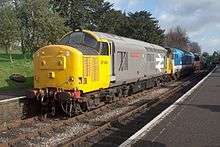
In 1986, four Class 37s, numbers 150/148/249/124, were converted to test the Mirrlees MB275T engine[16] and Brush alternator for the proposed Class 38, and were numbered 37901-4. These were followed in 1987 by 37905/6, converted from 37136/206, and fitted with the alternative pairing of a Ruston RK270T engine and GEC alternator.[16] All six locomotives were fitted with new bogies, and had ballast weights to increase their overall weight to 120 tons. Although intended as a testbed for the Class 38, the two power units fitted were those considered for the Class 60, which was eventually delivered with an enlarged version of the Mirrlees MB275T. They all had modifications similar to that of Class 37/7, including new nose grilles, removal of the central bodyside windows and 4 fire extinguisher ports. However, 37901-904 had a heavily modified central roof section, consisting of flat panels rather than the curved sheets of the original. All 6 had a new exhaust port fitted, replacing the two of the original design.
All six Class 37/9s were delivered in Railfreight Grey livery, later receiving 3TG metals sub sector livery, and operated as part of the British Rail Heavy Metals sector, being based in South Wales and hauling trains normally rostered for the much more powerful Class 56 such as the Port Talbot Steelworks - Llanwern Iron Ore tipplers.[17] During the late 1990s, use of the Class 37/9s declined due to availability of the newer and more powerful Class 66s and problems maintaining such a small number of non-standard locos, with all six officially designated as being in storage in 1999.
This was not, however, the end of the sub-class. In July 2000, 37906 was designated as part of the EWS heritage fleet but has since been sold into preservation, joining 37901 and 37905. 37902 was sold to Direct Rail Services in 2003, but was scrapped and cut up in 2005 after a review by DRS. 37904 was cut up at Booths in Rotherham in November 2004 and 37903 was scrapped at Crewe Diesel TMD in April 2005.
Operations
British Rail
During the time of British Rail, the Class 37s found use on both passenger and freight workings, being one of the mainstays of the BR fleet. While freight use was widespread, passenger work was predominantly in the Eastern Region with use on London - Norwich and Cambridge/King's Lynn services, the latter through to the 1980s and in West Wales on services west of Swansea to Fishguard, Milford Haven and Pembroke Dock. Darnall's (later Tinsley's) 37s were used on various passenger services in the Sheffield area, notably the Pullman service to King's Cross. Hull Dairycoats' 37s were used on local stopping services as well as on King's Cross portions down to Doncaster.
In the early 1980s, the remaining steam-heat capable locomotives gravitated to Scotland, eventually replacing both Class 27s on the West Highland Line and Class 26s on the Far North and Kyle lines. However, their use became tricky once ETH-fitted Mark 2 and Mark 3 coaches moved north. The sleeper trains were a particular problem. To this end, steam-heat 37/0s were coupled to ETHELs (Electric Train Heating Ex-Locomotive - essentially Class 25s with isolated traction motors that provided Electric Train Heating) which provided the necessary power to run them.
Class 37s were subject to several modifications during their time in service. One short-lived experiment involved 37175 receiving CP5 'self-steering bogies' designed to reduce excess wear and noise on the tightly-curved West Highland line to Fort William and Mallaig. This however, proved too expensive to be practicable. Some Inverness-allocated Class 37s received 'car lights'; these were essentially spotlights that made them more visible on the sharply curved Scottish branches, especially to users of level crossings. These were eventually either removed or superseded by the modern 'sealed beam' lights that became compulsory from 1993. Other classes fitted with these or similar lights were Class 24s, Class 26s, Class 47s and a solitary Class 86 86225.
The other notable use was of nominally freight locomotives to Aberystwyth over the Cambrian line, in this case taking over from Class 25s on the holiday trains.
From 1985, the 37/4 subclass took over on the Scottish lines although the use of original 37/0s continued in the summer when train supply was not required. The Welsh allocation in turn took over from the 37/0s on the Cambrian as well as from Class 33s on Crewe - Cardiff workings. They were also used on the Bristol - Cardiff/Swansea leg of services from Portsmouth and later on the Weymouth line.
Over time they were displaced from most passenger work by new build DMUs such as the Sprinter units, though they still found work in the summer and on secondary services from time to time through the 1990s as traffic demand required. This saw use both on the North Wales Coast and, most remarkably, Cardiff - Rhymney local services through to 2006. In Scotland after being displaced from the West Highland and far north routes, 37/4s were used on 2 diagrams on the Inverness - Edinburgh route for several years as well as being used to Kyle in the summer and on Inverness - Aberdeen services. The final daily work in Scotland was the Fort William sleeper train, this ending in June 2006.
Their freight work similarly reduced, being displaced by higher powered locomotives such as the Class 56 and Class 58 locomotives on coal trains, though they continued on other cargos such as oil tankers for longer.
Post privatisation
In the 1980s many locomotives were refurbished, which has meant the Class 37 fleet is one of the longest surviving classes on British railways. However, the introduction of new Class 66 locomotives has meant many 37s have been withdrawn or scrapped. English Welsh & Scottish and Direct Rail Services operated small fleets, with several other examples also operated by spot-hire companies. However, second-hand Class 37s have also proved popular in the export market, with some examples operating in Spain and France, serving the construction of those countries' high-speed railway networks. As of 2018, examples of the class are still in mainline service despite being more than 50 years old.
Colas Rail
Colas Rail owns ex-preservation 37057, 37099, 37116, 37175, 37219, 37254, 37421, all currently operational. 37175 and 37219 are being used in 2014 Rail Head Treatment Trains working off Kings Norton but in 2015, Colas Class 47s (47727 and 47739) are on this duty.
Additionally, Colas purchased 37146, 37188 and 37207 with the intention of returning them to main line duty but as of November 2017 37146 and 37188 are unlikely to receive their intended overhaul and are expected to be sold or used as parts donors.
Direct Rail Services

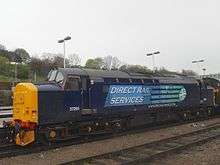
Direct Rail Services has a variety of Class 37s operational, and others stored. DRS operates five 37/0s, eight 37/4s (nine when the work on 37407 is completed), three 37/5s and 5 37/6s . Most of the DRS 37s were used on nuclear flask services coming from a host of places including Hunterston, Torness, Heysham, Hartlepool, Sizewell, Bridgwater, Valley, Dungeness, but are now being replaced by class 68s. These are empty or full FNA wagons often containing spent nuclear fuel. On 9 January 2016 DRS listed six Class 37 locomotives (37503/10/21 and 37608/11/70) for sale.[18]
In July 2016, 37424 was renumbered 37558 and named Avro Vulcan XH558.[19][20]
DRS's Class 37s haul some passenger services on the Cumbrian Coast Line, under contract to Northern.
DB Schenker (formerly EWS)
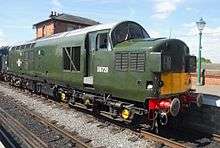
EWS usually used Class 37s in pairs, for freight workings. Additionally EWS used the Class 37s on railtours or charter hire to train operating companies. For example, in 2005 Arriva Trains Wales used 37/4 haulage on the Rhymney valley line, from a pool of four locomotives, these locomotives being 37405 (EWS livery), 37425 (BR Large Logo), 37411 (BR green livery), 37419 (EW&S livery), This loco replaced 37408 Loch Rannoch which was involved in a collision with parked stock at Rhymney sidings, which was suspected to be caused by vandals. 37408 suffered from severe extensive damage and was written off at Toton TMD with its power unit removed and used to revive 37422. Its body was later scrapped at European Metal Recycling, Kingsbury, Warwickshire.
By mid-2008, only three EWS Class 37s were still in regular use on the mainline (37401, 417 & 422). 37422 was placed in WNTS tactical store pool in September leaving only 37401 and 417 in traffic. On 16 December, 37417 suffered serious engine failure and was sent to Eastleigh for storage, resulting in 37401 the only Class 37 to remain in traffic into the new DB Schenker era.
The former EWS, DB Schenker (UK) had one operational Class 37/4, 37401 at the time of its creation on 1 January 2009. DB Schenker also has hired locomotives for temporary duties, such as 37423 from Direct Rail Services (DRS) to cover for failed 37417. DB Schenker 37401 (and DRS's 37423) were on snowplough duty at Inverness for the winter months. 37401, DB Schenker's sole operational English Electric type 3 at the time, was reported sounding rough, and was later stored although this did not last long as it was soon sent to Toton TMD for repairs along with 37406 The Saltire Society.
37401, DB Schenker's most reliable Class 37, was repaired and returned to service. 37406 was returned to service, failing on its first working. 37670 was also returned operational.
37419 was prepared for a return to traffic and saw itself repainted into DB Schenker livery, however its long time in store did not help its power unit and it failed with a serious engine fault on its trial run. The locomotive is now operational with Direct Rail Services.
DB Schenker had the largest route for railhead treatment trains for Autumn 2009 and required Class 37 haulage due to their route availability. Much speculation was surrounding the return of several Class 37s, however DB Schenker were eventually given clearance from Network Rail to use Class 66s and 67s on the routes instead, resulting in the Class 37 plan being ditched despite several of the machines having their air horns moved onto the nose to resolve clearance problems.
Reliability problems plagued 37670 during its short time in traffic and the loco was eventually stored unserviceable.
With the storage of 37670, this meant that once again 37401 was the sole operational Class 37 in active service under DB Schenker. To take the load strain off 37401, 37425 Pride of the Valleys was fitted with OTMR safety equipment and was returned fully operational. The locomotive retained in BR blue large logo livery, however like 37670 it was also plagued with unreliability.
As of summer 2010, DB Schenker Rail UK ceased using Class 37s.
In June 2013, DB Schenker offered six Class 37s for sale: 37703, 37714, 37716, 37718, 37800 and 37884. These had been stored out of use at Dollands Moor after returning from mainland Europe, where they had been working on the construction of a new high speed line.[21] 37703 went on hire/loaned (but still owned by Direct Rail Services) to the Scottish Railway Preservation Society, 37703/714/716/718 were bought by Direct Rail Services. 37718 was scrapped at CF Booth, Rotherham in July 2015. 37800 & 37884 were bought by Europhoenix and once restored to working order, went on long term hire to Rail Operations Group in a dual Europhoenix/ROG livery.
West Coast Railway Company
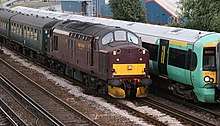
The West Coast Railway Company (WCRC) purchased four locomotives from Ian Riley Engineering in 2004. The two operational locomotives (nos. 37197 and 37261) were used on charter trains or as standby locomotives for The Jacobite steam-hauled excursion services from Fort William to Mallaig during 2005. These two, along with non-operational 37423, have since been sold to DRS. The fourth (no. 37235) was for spares.
In late 2007, WCRC purchased several non-operational Class 37/5 and Class 37/7s from EWS: nos. 37517, 37668, 37676, 37685, 37706, 37712 and 37710. Of the acquired locomotives 37710 will be used as a source of spares, 37676 and 37712 were the first two returned to mainline. 37676 was named Loch Rannoch at a special event in Carnforth Steamtown. 37712 suffered a fire on an empty coaching stock move and was subsequently stored. It is known that major work will need to be done on 37712, however demand exists for chartered Class 37s.
By the end of 2016, WCRC had five Class 37s running in service: nos. 37516, 37668, 37669, 37685, 37706 with nos. 37517, 37710, 37712 stored and no. 37676 undergoing repairs.
Rail Operations Group
Rail Operations Group (ROG) lease 5 Class 37s (37884, 37800, 37601, 37608 & 37611) from Europhoenix for frequent moves of passenger stock, such as the Class 375s, Class 319s and Class 345s.
Fleet Summary
Fleet summary 2018 of mainline registered locomotives (excluding preserved railways).
| Owner | Number | Numbers | Notes |
|---|---|---|---|
| Colas Rail | 14 | 37025, 057, 099, 116, 175, 219, 254, 421, 521, 607**, 610**, 612**. Stored; 37146*, 188*, 207, 418. | *Acquired from preservation but unlikely to be returned to traffic. **On hire from Harry Needle Railroad Company. |
| Direct Rail Services | 24 | 37 038, 059, 069, 218, 259, 401-403, 405, 407, 409, 419, 422-425, 602, 605, 606, 716. Stored; 603, 604, 609 and 703. | 37703 on loan to Bo'ness & Kinnel Railway. 401-403 & 425 Hired to Northern Rail for Cumbrian Coast Services. |
| Europhoenix | 8 | 37601*, 608*, 611*, 800*, 884*, 901. Stored 37503, 510, 670 | *Hired to Rail Operations Group. 37 670 is an empty shell. |
| Harry Needle Railroad Company | 2 | 37607, 610, 612. | 37607, 610 & 612 hired to Colas. HNRC were originally tasked with locating and overhauling class 37s for Colas.[22] |
| Locomotive Services Limited | 1 | 37667 | |
| Network Rail | 5 | 97301 (37 100), 97302 (37 170), 97303 (37178), 97304 (37217). Stored; 37198 | ERTMS fitted for Cambrian Lines |
| UK Rail Leasing | 2 | 37905, 906 | |
| West Coast Railways | 11 | 37516, 515, 669, 685, 706. Stored; 37165*, 517*, 668, 676, 710*, 712. | *Spares donors |
| Total | 67 |
Source [23]
Accidents and incidents
- In January 1988, locomotives No. 37 671 and 37 672 were hauling a freight train that was diverted into a siding at Tavistock Junction, Devon due to a pointsman's error. The train collided with a wagon, pushed it through the buffers and was derailed.[24]
- There is a myth that 37069 Thornaby TMD is haunted by a driver who was killed when an object, thrown up by a passing Deltic between Northallerton and York, smashed through the window. The horn is said to randomly blow and fire bottles have been set off.[25]
Departmental
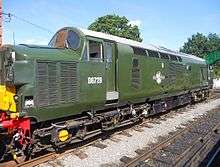
Network Rail ERTMS project
Network Rail restored four Class 37s as part of the European Rail Traffic Management System (ERTMS) trial project on the Cambrian Line. The site of the restoration was the Barrow Hill Roundhouse, where ex-HNRC locomotives 37100, 37170, 37178 and 37217 were taken in. The restored Class 37s for ERTMS use were re-designated as Class 97/3, numbered 97301, 97302, 97303 and 97304.[26]
The class was chosen because of its original fitment with both air and vacuum braking, a feature which will allow them to pull both modern freight trains as well as steam specials. The main work of the locomotives is to pull on-track machines (such as tampers) through the ERTMS section.
The 97/3s are based at the newly constructed Coleham Depot for the duration of the ERTMS testing on the Cambrian Line, thereafter they are used to pilot trains not fitted with the ERTMS signalling system. They are also used to work Network Rail test trains on other parts of the network when not required for ERTMS testing.
These locos were effectively refurbished, having been completely stripped down to bare steel, with reconditioned engines, somewhat updated cabs, all new signalling systems installed (ERTMS in this instance) and extensive re-wiring.
Preservation
Class 37 locomotives have proved to be very popular, with many examples saved for preservation on heritage railways or by enthusiast groups. Notable examples saved include the first-built locomotive, no. D6700, and the last built locomotive 37308. A number of the class have been sold back out of preservation to mainline operators including Mirrlees-engined prototype no. 37901, and both Ruston-engined prototypes nos. 37905 and 37906. One locomotive, 37372, has been procured by a group called the Baby Deltic Project for conversion into a replica of a Class 23 Baby Deltic.[27]
| Pre TOPS |
Post TOPS |
Final | Name | Owner | Location | Notes or livery |
|---|---|---|---|---|---|---|
| D6607 | 37307 | 37403 | Isle of Mull | On loan to DRS | BR Blue Large Logo. | |
| D6608 | 37308 | 37274 | Dean Forest Railway[pre 1] | Sky Blue undercoat | ||
| D6700 | 37119 | 37350 | (National Railway Museum) | National Railway Museum | National Railway Museum | First locomotive of class built. BR Green |
| D6703 | 37003 | no name plates currently carried | Class 37 Locomotive Group.[pre 2] | Mid Norfolk Railway (currently at UKRL Leicester | BR Blue
Currently undergoing major overhaul at UKRL Leicester as of August 2017. | |
| D6709 | 37009 | 37340 | English Electric Preservation | Great Central Railway (North) | Undergoing restoration. BR Blue | |
| D6723 | 37023 | - | (Stratford) | Privately owned | Allely's yard in Studley | Undergoing restoration. BR Blue Large Logo. |
| D6724 | 37024 | 37714 | Great Central Railway | Trainload Metals livery. | ||
| D6725 | 37025 | - | Inverness TMD[pre 3] | The Scottish Thirtyseven Group[pre 4] | On loan to Colas | BR Blue Large Logo. Restored in 2005. returned to mainline use 2016.[pre 3] |
| D6729 | 37029 | - | Privately owned | Epping Ongar Railway | BR Green, small warning panel. | |
| D6732 | 37032 | 37353 | Mirage | Privately owned[pre 5] / Anglia type three association[pre 6] | North Norfolk Railway | BR Green. In Service.[pre 6] |
| D6737 | 37037 | 37321 | (Gartcosh) | Devon Diesel Society[pre 7] | BR Green. Nameplates now removed. | |
| D6742 | 37042 | - | Eden Valley Railway | "Almost Runnable" EWS Livery | ||
| D6775 | 37075 | - | Privately owned | Keighley & Worth Valley Railway | 3TG unbranded | |
| D6797 | 37097 | - | Old Fettercairn | Caledonian Railway Diesel Group[pre 8] | Caledonian Railway[pre 9] | Under Overhaul[pre 9] BR Blue |
| D6808 | 37108 | 37325 | Privately owned | Crewe Heritage Centre | Under restoration. Dutch undercoat | |
| D6809 | 37109 | - | Privately owned | East Lancashire Railway | BR Blue | |
| D6823 | 37123 | 37679 | Privately owned | Burton Wagon Works - Nemesis | Currently undergoing long-term restoration. Railfreight 3 Tone Grey: Unspecified Sub-Sector | |
| D6842 | 37142 | - | Bodmin & Wenford Railway[pre 10] | |||
| D6852 | 37152 | 37310 | (British Steel Ravenscraig) | Privately owned[pre 11] | Peak Rail[pre 11] | Railfreight Red Stripe, in working order (Sept. 2006)[pre 11] |
| D6869 | 37169 | 37674 | St Blaize Church 1445–1995 | Privately owned | Stainmore Railway, Kirkby Stephen | Railfreight Red Stripe, operational (as of November 2014) |
| D6890 | 37190 | 37314 | (Dalzell) | Class Forty Appeal[pre 12] | Midland Railway Butterley | BR Blue |
| D6905 | 37205 | 37688 | Great Rocks. | Kingmoor TMD. | Mid Norfolk Railway | DRS Blue |
| D6915 | 37215 | - | The Growler Group | Gloucestershire Warwickshire Railway[pre 13] | In working order 1998.[pre 13] | |
| D6916 | 37216 | - | (Great Eastern) | Private | Pontypool and Blaenavon Railway[pre 14] | Mainline Blue livery. Undergoing restoration to BR Green |
| D6927 | 37227 | - | Chinnor and Princes Risborough Railway | Operational | ||
| D6940 | 37240 | Llangollen Diesel Group[pre 15] | Llangollen Railway | In working order 2015 following bogie repairs. BR Blue | ||
| D6948 | 37248 | - | (Midland Railway Center/Loch Arkaig) | Privately owned - in custodianship of 'The Growler Group' | Gloucestershire Warwickshire Railway | BR Green. |
| D6950 | 37250 | - | Privately owned | Wensleydale Railway | Awaiting attention, Triple grey with Transrail logo; to go Railfreight Metals (2015) | |
| D6955 | 37255 | - | Privately owned[pre 16] | Great Central Railway[pre 16] | Civil Engineers. | |
| D6961 | 37261 | - | (Caithness) | Privately owned | Bo'ness and Kinneil Railway | |
| D6963 | 37263 | - | Privately owned | Telford Steam Railway | BR Blue | |
| D6964 | 37264 | - | Privately Owned | North Yorkshire Moors Railway | BR Large logo Blue | |
| D6971 | 37271 | 37418 | (An Comunn Galdhealach/Pectinidae/East Lancashire Railway) | Privately owned | East Lancashire Railway | Operational. BR Blue Large Logo. (Minus Arrows and numbers) |
| D6975 | 37275 | - | (Stainless Pioneer/Oor Wullie) | South Devon Railway | BR Blue | |
| D6994 | 37294 | - | Embsay | BR Blue |

See also
References
- 1 2 3 4 5 6 7 8 "Class 37". The Railway Centre. Retrieved 25 March 2014.
- ↑ "Locomotive Database - BR Class 37 Technical Data". Auran.com. Retrieved 25 March 2014.
- 1 2 "Locomotive, DMU and EMU Nicknames". Rodge.force9.co.uk. Archived from the original on 30 January 2010. Retrieved 25 March 2014.
- ↑ http://www.brdatabase.info/locoqry.php?action=class&type=D&id=32
- ↑ "Class 37 English Electric Type 3 : kentrail.co.uk (Background to original order)". kentrail.co.uk. Retrieved 25 March 2014.
- ↑ 1,750HP Diesel-Electric Locomotives : New British Railways standard in type 3 power range (Copy of original English Electric technical pamphlet giving technical specifications of the original design). Archived 4 July 2010 at the Wayback Machine.
- ↑ Clough 2009, p. 86
- ↑ Clough 2009, p. 87
- ↑ Clough 2009, p. 88
- ↑ Clough 2009, pp. 86–88
- ↑ ENGLISH ELECTRIC CLASS 37 Renumbering the type 3s Archived 28 June 2008 at the Wayback Machine.
- ↑ Morrison, Brian (1981). The Power of the 37s. Oxford: Oxford Publishing Co.
- ↑ Rolling stock : class 37, English Electric/BR thejunction.org.uk
- ↑ "The European Railway Picture Gallery Class 37/4 data sheet". Railfaneurope.net. 13 May 1965. Retrieved 25 March 2014.
- ↑ Rail Express April 2011
- 1 2 "Enter the Super 'Syphons'". Rail Enthusiast. No. 63. EMAP National Publications. December 1986. pp. 55–57. ISSN 0262-561X. OCLC 49957965.
- ↑ Banks, Alan (December 2007). "Masterclass : BR Class 37/9s". Model Rail. No. 111. Peterborough: EMAP active Ltd. pp. 18–24.
- ↑ http://www.directrailservices.com/news-articles/2016/01/08/sale-of-surplus-assets/
- ↑ "Welcome to a 'new' mainline locomotive - Avro Vulcan XH558". Vulcan to the Sky Trust. Retrieved 4 August 2016.
- ↑ "DRS Open Day 2016 - A Great Success". Direct Rail Services. Retrieved 4 August 2016.
- ↑ "More 1960s redundant Class 37 diesel locomotives put up for sale by DB Schenker". Rail.co.uk. Retrieved 25 March 2014.
- ↑ https://www.railmagazine.com/trains/specifications/golden-oldies-continue-to-play-their-tune?p=3
- ↑ http://www.abrail.co.uk/diesellocodetail.htm
- ↑ Earnshaw 1993, pp. 39, rear cover.
- ↑ Paul Screeton (2014). "7". Haunted Hartlepool & East Durham. History Press. pp. 104–106. ISBN 978-0-7509-5535-5.
- ↑ Class 97 Status Archived 13 February 2009 at the Wayback Machine. wnxx.com, retrieved on 13 September 2008
- ↑ The Project - The Baby Deltic Project
- ↑ "Data from 37group data page". C37lg.co.uk. Archived from the original on 26 March 2014. Retrieved 25 March 2014.
Preserved locomotives
- ↑ Fleet status :UK locomotive database - subsection "31-37" Archived 20 October 2007 at the Wayback Machine. wnxx.net
- ↑ "Class 37 Locomotive Group". C37lg.co.uk. Retrieved 25 March 2014.
- 1 2 Scottish Railway Preservation Society Diesel Group: 37 025 Archived 14 October 2008 at the Wayback Machine. srpsdiesel.com
- ↑ Scottish 37 Group Archived 7 February 2007 at the Wayback Machine.
- ↑ 37032 (D6732) Archived 31 May 2009 at the Wayback Machine. preserved-diesels.co.uk
- 1 2 Class 37 D6732 (37032) Archived 18 August 2008 at the Wayback Machine. Midland and Great Northern joint railway society mandgn.co.uk
- ↑ BR Co-Co D6737 (37 037 Loch Treig) southdevonrailway.co.uk
- ↑ 37097 "Old Fettercairn" Archived 20 November 2008 at the Wayback Machine. crdg.co.uk
- 1 2 Caledonian Railway subsection Stocklist caledonianrailway.co.uk
- ↑ 37142 Archived 5 July 2008 at the Wayback Machine. bodminandwenfordrailway.co.uk
- 1 2 3 37152 peakraildiesels
- ↑ 37314 Class Forty Appeal
- 1 2 Gloucester Warwickshire Railway - Locomotives (subsection 'diesel') Archived 27 March 2009 at the Wayback Machine. gwsr.com
- ↑ DIESEL LOCOMOTIVES AT BLAENAVON Archived 19 August 2008 at the Wayback Machine. pontypool-and-bleanavon.co.uk
- ↑ "Heritage Traction on the Llangollen Railway | BRCW Type 2 D5310, EE Type 3 D6940, Brush Type 4 D1566". Llangollen-diesels.org.uk. Retrieved 25 March 2014.
- 1 2 Locomotives of the Great Central Railway : 37255 Archived 24 June 2012 at the Wayback Machine. gcrailway.co.uk
Sources
- Clough, David N. (August 2009). British Rail Standard Diesels of the 1960s. Hersham: Ian Allan. ISBN 978-0-7110-3373-3. 0908/B1.
- Earnshaw, Alan (1993). Trains in Trouble: Vol. 8. Penryn: Atlantic Books. ISBN 0-906899-52-4.
- Marsden, Colin J. (1981). Motive power recognition:1 Locomotives. Shepperton: Ian Allen Ltd. ISBN 0-7110-1109-5.
- Preedy, Norman E; Ford, H L. BR Diesels in Close-Up. Truro: D Bradford Barton Ltd.
- Williams, Alan; Percival, David (1977). British Railways Locomotives and Multiple Units including Preserved Locomotives 1977. Shepperton: Ian Allen Ltd. ISBN 0-7110-0751-9.
Further reading
- Clough, David N.; Rapson, D.I. (1991). Locomotive Recognition: Class 37s. Ian Allan. ISBN 9780711019195. OCLC 26632324.
- Collins, Michael J. (1984). Class 37s at Work. London: Littlehampton Book Services Ltd. ISBN 9780711014473. OCLC 14931264.
- Derrick, Kevin (2011). Looking Back At Class 37 Locomotives. Strathwood. ISBN 9781905276240.
- Derrick, Kevin (2015). Syphon Salute - 50 Years of Class 37s. Strathwood. ISBN 9781905276752.
- Loader, Martin (1998). Class 37 Photo File. Vanguard Publications. ISBN 9781900872027. OCLC 655247051.
- McManus, Michael. Ultimate Allocations, British Railways Locomotives 1948–1968. Wirral. Michael McManus.
- Meskell, Nick (2006). Class 37s in South Wales. Blackpool: Train Crazy Publishing. ISBN 9780954803575. OCLC 171537608.
- Meskell, N.J. (2004). Scottish Class 37s. One - The Steam Heat Years. Blackpool: Train Crazy Publishing. ISBN 9780954803513. OCLC 190776403.
- Meskell, N.J. (2005). Scottish Class 37s. Two. Blackpool: Train Crazy Publishing. ISBN 9780954803544. OCLC 190776403.
- Meskell, N.J. (2007). Scottish Class 37s. Three - The 1990s. Blackpool: Train Crazy Publishing. ISBN 9780954803582. OCLC 190776403.
- Oakley, Michael (1979). BR-EE Class 37 diesel electrics. Truro: Barton. ISBN 9780851533629. OCLC 16499594.
- Shannon, Paul (2005). Rail Portfolios: Class 37. Hersham: Ian Allan. ISBN 9780711030978. OCLC 58554935.
- Shannon, Paul (1990). The 37s-Second Series. Shepperton: Ian Allan. ISBN 9780711019317. OCLC 60085212.
- Siviter, Roger (1989). 37s in the Highlands. Runpast Publishing. ISBN 9780946184521. OCLC 20691702.
- Vaughan, John (2007). Diesel Retrospective: Class 37. Hersham: Ian Allan. ISBN 9780711032002. OCLC 85897919.
- Walker, Andrew (2016). Class 37 Locomotives. Amberley Publishing. ISBN 9781445657370. OCLC 934603454.
- Doel, Peter (December 1981 – January 1982). "Howay the 37s!". Rail Enthusiast. EMAP National Publications. p. 60. ISSN 0262-561X. OCLC 49957965.
- Kelly, Peter (September 1982). "Rolling Stones!". Rail Enthusiast. EMAP National Publications. pp. 18–21. ISSN 0262-561X. OCLC 49957965.
- Cowley, Ian; Hardinge, Graham (October 1986). "The Great Eastern Class 37s: The First 25 Years". Rail Enthusiast. No. 61. EMAP National Publications. pp. I–XVI. ISSN 0262-561X. OCLC 49957965.
- Clough, David (5–18 October 1989). "6 of the best". RAIL. No. 106. EMAP National Publications. pp. 34–37. ISSN 0953-4563. OCLC 49953699.
- Dunn, Pip (23 April – 6 May 1997). "All in a day's work: Class 37/4". RAIL. No. 303. EMAP Apex Publications. pp. 22–26. ISSN 0953-4563. OCLC 49953699.
- Dunn, Pip (16–29 July 1997). "Probably the best locomotive in the world!". RAIL. No. 309. EMAP Apex Publications. pp. 40–45. ISSN 0953-4563. OCLC 49953699.
- Dunn, Pip (30 July – 12 August 1997). "Re-birth of a classic". RAIL. No. 310. EMAP Apex Publications. pp. 28–34. ISSN 0953-4563. OCLC 49953699.
- Dunn, Pip (12–25 August 1998). "Clean and green - a pioneer is honoured at last". RAIL. No. 337. EMAP Apex Publications. pp. 36–40. ISSN 0953-4563. OCLC 49953699.
External links
| Wikimedia Commons has media related to British Rail Class 37. |
- The Class 37 Locomotive Group Owners of 37003
- The Growler Group Class 37 37215, 37248 (custodians)
- Class 37 Locomotive Data Site
- English Electric Preservation Class 37 - D6709